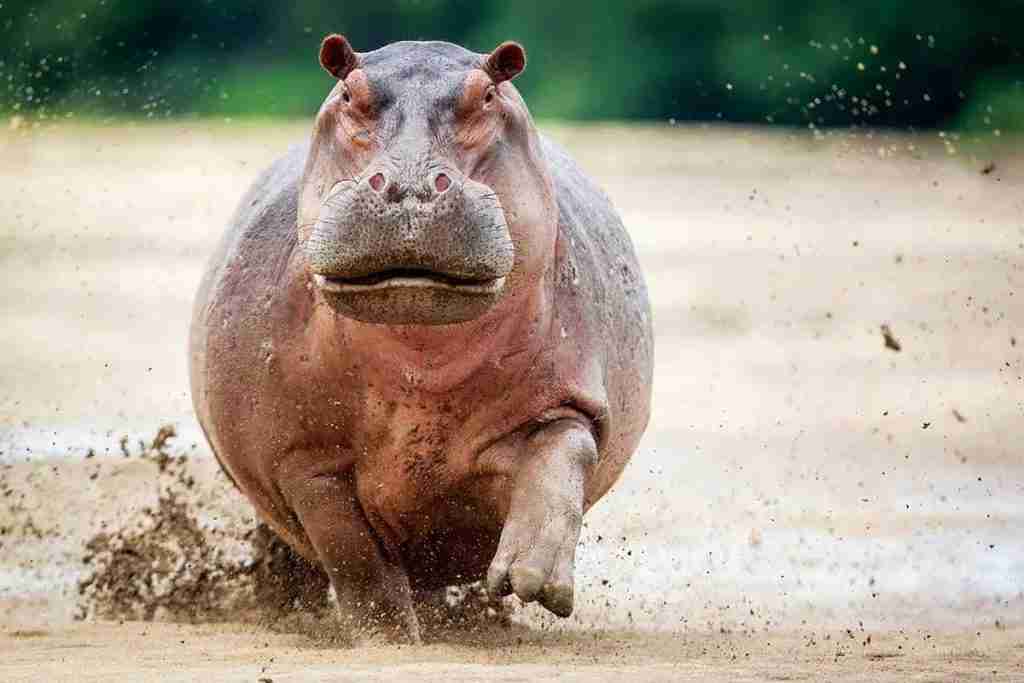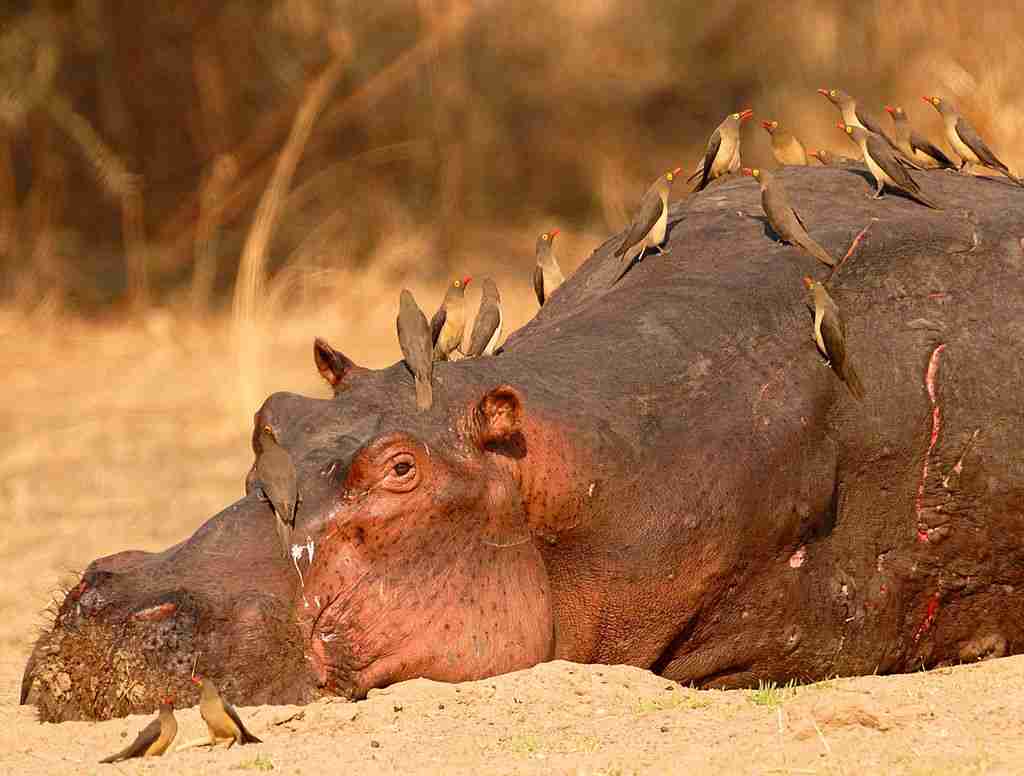22 Fun Facts About Hippos | Chubby Water Giants
1. The Word Hippopotamus comes from the ancient Greek for River Horse.
The word ‘hippopotamus‘ has Greek roots, meaning ‘river horse’ because of its horse-like appearance and river habitat. It blends ‘hippos’ (horses) and ‘potamos’ (river).
In English, we say ‘hippopotamuses’ or ‘hippopotami’ for more than one. The nickname ‘hippo’ is just a shorter way to say this big word.
2. Hippos can open their large mouths up to 150 degrees wide.
Hippos can open their mouths up to 150 degrees wide, showing off their big teeth as a sign of strength. It is not just for show; it’s a display of dominance and a warning to others.
Their jaws are specially designed to open wide, making their mouth one of the largest on land, second only to the blue whale.
3. Hippos have been known to rescue other animals from drowning.
One of the most interesting facts about hippos is their territorial nature, which can lead to unexpected rescues.
In instances like at Kruger National Park, hippos have been seen charging at crocodiles to protect their territory, inadvertently saving other animals, such as wildebeests, from being dragged underwater. Their aggressive behavior is more about marking territory than heroism.
4. Hippos secrete a natural red oily sunscreen to avoid sunburn.
Hippos produce a unique ‘sweat’ that acts as a natural sunscreen and antibiotic. This red and orange oily liquid, according to a 2004 study, protects their skin from the sun’s harmful UV rays and prevents bacterial infections.
Secreted from their skin’s mucous glands, it starts colorless, then turns red-orange and darkens, shielding these African mammals from sunburn and skin damage.
5. Hippos communicate through loud grunts and wheezes.
Hippos communicate with grunts and ‘wheeze honks’ as loud as thunder, audible over a mile away. A study by the University of Saint-Etienne, France revealed these sounds help hippos identify each other, distinguishing friends from foes.
Researchers found hippos can recognize individual ‘voices,’ supporting their social bonds. This discovery highlights the complexity of hippo communication and their sophisticated social structure.
6. Hippos have their eyes, ears, and nostrils on the top of their head.
Another unique hippo fact is their eyes, ears, and nostrils are positioned on the top of their heads. This special placement allows them to breathe, see, and hear while mostly submerged in water.
Their valvular nostrils can close to keep water out, enabling hippos to stay underwater without drowning, perfectly adapting them to their semi-aquatic lifestyle.
7. Baby hippos can suckle underwater by closing their ears and nostrils.
Baby hippos, called calves, are born weighing between 30-100 pounds with minimal fur. They’re uniquely adapted to their aquatic life, capable of suckling underwater by closing their ears and nostrils to avoid water intake.
Calves depend on their mother’s milk for about a year, spending up to 16 hours daily submerged, showcasing their remarkable adaptation to the aquatic environment from birth.
8. Hippos are mostly active and foraging for food at night.

Hippos are primarily active at night, venturing out to graze on grass for about six hours after sunset. Although not nocturnal, they spend daylight hours in water to stay cool, emerging at dusk to eat.
Remarkably, in one night, a hippo can consume up to 35kg of grass, which is only about 1 to 1.5% of its body weight daily.
9. What do hippos eat?
Hippos are herbivores, primarily feasting on short grasses, though they’ll also eat fruit, leaves, and aquatic plants.
While the common hippo prefers grazing on grass, the pygmy hippo’s diet mainly consists of leaves. Each night, a hippo consumes around 88 pounds of food.
10. Hippos can hold their breath underwater for up to 5 minutes.
One of the most interesting facts about hippos is their ability to hold their breath underwater for up to five minutes. Their ears and nostrils close to keep water out, allowing them to nap in water during the day.
A reflex helps them surface for air without waking. Even their eyes are protected by a clear membrane, acting like built-in goggles.
11. Hippos’ sweat acts as an antiseptic and helps heal wounds.
Hippos oily fluid is not only a natural sunscreen but also acts as an antiseptic. This remarkable sweat helps hippos stay mostly free from infections, even with the wounds they often get from fighting.
Its healing properties are essential for their survival, aiding in the quick recovery of injuries sustained during their frequent skirmishes.
12. Despite their size, hippos can run fast on land, up to 30 km/h.

Despite their hefty size and short legs, hippos are surprisingly fast runners, capable of reaching speeds up to 30 km/h (19 mph) on land. This speed is impressive for such large animals, allowing them to trot and even gallop over short distances.
While they can’t jump, hippos can swiftly navigate steep banks, showcasing their agility and speed when necessary.
13. Hippos have large canine teeth that can grow up to 50 cm.
Hippos possess some of the largest teeth among land mammals, with their canines growing up to 50 cm (20 inches) long. Despite their seemingly gentle appearance, they are highly aggressive, using their continuously growing teeth for combat.
Their powerful jaws can exert a bite force of 2,000 PSI, making their bite one of the strongest in Africa, far surpassing lions and even jaguars.
14. Hippos spend most of the day in water to keep their bodies cool.
Hippos spend the majority of their day submerged in rivers, lakes, and mangroves to protect their sensitive skin from the harsh African sun and prevent dehydration.
Their thick skin requires constant moisture, as they lack true sweat glands. Instead, they produce a unique ‘blood sweat,’ a red, thick substance that keeps them cool, and wet and safeguards their skin against burning and drying out.
15. Hippos mark their territory by spinning their tails while pooping.
Another interesting hippo fact is their unique way of marking territory through muck-spreading. By vigorously wagging their tails while defecating, hippos scatter their feces widely.
This behavior not only marks their territory but also trails from water to grazing areas. Hippos are more likely to perform this when they encounter unfamiliar hippo sounds, using their tails as propellers to spread their message.
16. Drug kingpin Pablo Escobar introduced hippos to Colombia.

One of the most lesser-known facts about hippopotamuses is their introduction to Colombia by drug kingpin Pablo Escobar in the 1980s.
Originally part of his extravagant private zoo, the four hippos have now grown to an estimated 170, roaming freely. By drug kingpin Pablo Escobar in the 1980s. Originally part of his extravagant private zoo, the four hippos have now grown to an estimated 170, roaming freely.
With no natural predators, they’ve become an invasive species, posing a threat to Colombia’s ecosystem and requiring population control measures.
17. How many people are killed by hippos?
Hippos are responsible for more human fatalities in Africa than any other large animal, causing an estimated 500 deaths annually. Their powerful bite, delivering 1,800 psi, and fiercely territorial nature make them extremely dangerous.
They often charge at boats, mistaking them for predators, and can easily outrun humans with their surprising speed of 20 mph in short bursts.
18. Hippos can sleep underwater, surfacing for air without waking up.
Hippos possess a remarkable ability to sleep underwater, thanks to a reflex that lets them surface for air without waking. Their ears and nostrils close tightly to prevent water intake, allowing them to hold their breath for up to five minutes.
This adaptation enables hippos to nap in water during the day, automatically bobbing up to breathe and sinking back down, ensuring they don’t drown while asleep.
19. Female hippos give birth in water.
Female hippos have an eight-month gestation and birth calves in water every two years for safety. Newborns, weighing nearly 100 pounds, can hold their breath for 90 seconds.
Mothers push them to the surface for their first breath. To safeguard against predators like crocodiles and lions, mother and calf quickly join groups of other hippos for protection.
20. Hippos have a mutualistic relationship with Barbel fish and Oxpeckers.

Hippos form mutualistic relationships with barbel fish and oxpecker birds for skin care. Barbels eat parasites off hippos’ skin and consume their droppings, while oxpeckers feed on insects by making small cuts on the hippos.
This partnership provides essential grooming and dental hygiene for hippos, unable to scratch their backs, benefiting both the fish, birds, and hippos themselves.
21. Can hippos swim?
Despite their aquatic lifestyle, hippos cannot swim or float due to their dense bodies. Instead, they walk or run along riverbeds, with their eyes and nostrils positioned on top of their heads allowing them to see and breathe while submerged.
Their unique body density ensures they stay grounded underwater, highlighting their adaptation to life in water without swimming.
22. Hippos were considered sacred in ancient Egypt.
The ancient Egyptians had a complex view of hippos, valuing them for their association with life and rebirth due to their habitat in the life-giving Nile River.
Despite their positive qualities, hippos were also feared for their aggression. They were hunted for their meat, skin, and large teeth, and depicted in art as both sacred creatures and symbols of chaos to be overcome by the king.
FAQs
Hippos display aggression due to their highly territorial nature, especially in water. Their aggression ensures the protection of their space and offspring from intruders, reflecting their instinct to dominate and defend.
Yes, a hippo can kill a crocodile. Despite crocodiles being formidable predators, hippos’ superior size, aggressive nature, and powerful jaws allow them to defend against or even kill crocodiles when threatened.
The biggest hippos can weigh up to 4,500 kilograms (9,920 pounds). These massive creatures are among the heaviest land animals, with their weight contributing to their dominance in aquatic environments.
Hippos evolved from a group of ancient mammals known as anthracotheres, about 55 million years ago. These semi-aquatic creatures are believed to share a common ancestor with modern whales and dolphins.
It’s estimated that there are between 115,000 and 130,000 hippos left in the world. Their populations are primarily found in sub-Saharan Africa, with conservation efforts ongoing to protect them from habitat loss and poaching.







